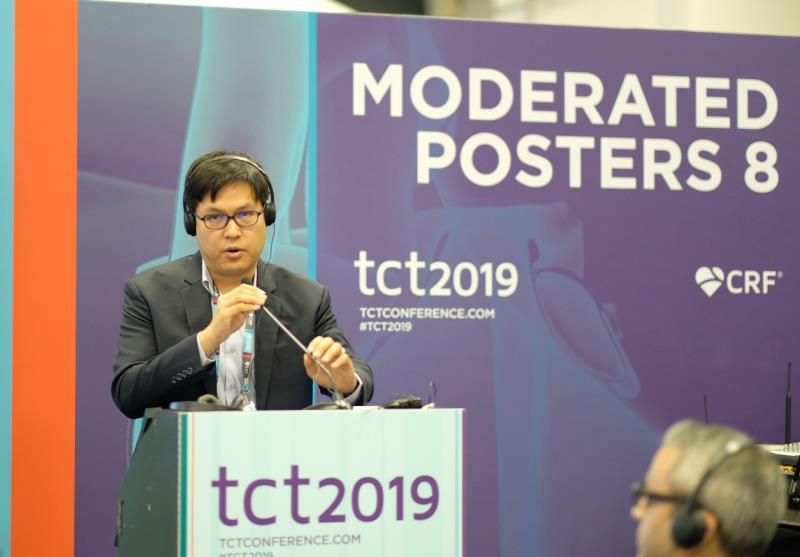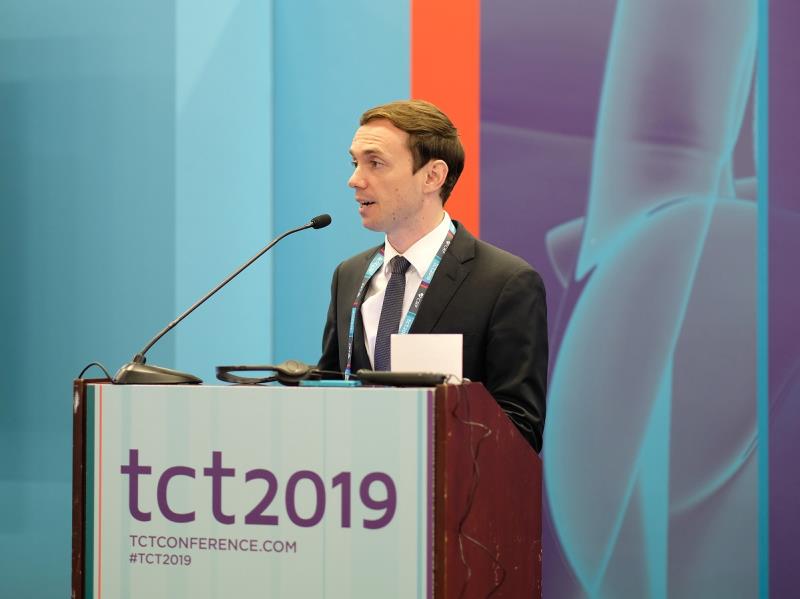 Dr Ply Chichareon discussing subgroup results from the GLOBAL LEADERS trial.
Dr Ply Chichareon discussing subgroup results from the GLOBAL LEADERS trial.Subgroup analyses of the GLOBAL LEADERS study showed similar treatment effects between ticagrelor and aspirin monotherapy following percutaneous coronary intervention (PCI) in patients with impaired renal function (IRF)* and diabetes.
GLOBAL LEADERS (n=15,991; mean age 65 years, 23 percent women) compared a regimen of ticagrelor for 23 months after a month of dual antiplatelet therapy (DAPT) against a 1-year regimen of aspirin following 1 year of DAPT. The primary endpoint was all-cause mortality or new Q-wave myocardial infarction (MI) at 2 years.
Outcomes based on renal function
Overall, patients with IRF (n=2,171; 38 percent female) had a higher incidence of the primary endpoint compared with those without IRF after adjusting for baseline differences (7.9 percent vs 3.5 percent; adjusted hazard ratio [adjHR], 1.65; p=0.001), as well as all-cause mortality (adjHR, 1.84; p=0.001), investigator-reported MI (adjHR, 1.54; p=0.001), and bleeding (BARC** type 3 or 5; HR, 1.42; p=0.01). [TCT 2019, abstract TCT-610]
Despite the higher risk for ischaemic and bleeding events in patients with IRF, no significant differences were observed between the two treatment strategies in terms of the primary endpoint (HR, 0.82; p=0.19; pinteraction=0.68), all-cause mortality (HR, 0.76; p=0.10; pinteraction=0.30), investigator-reported MI (HR, 1.04; p=0.86; pinteraction=0.82), and bleeding (HR, 1.10; p=0.66; pinteraction=0.48).
“Nevertheless, when including estimated glomerular filtration rate (eGFR) as a continuous variable in the model, there was an interaction with bleeding … The difference between HRs increased as eGFR decreased,” said Dr Mariusz Tomaniak from the Erasmus Medical Center in Rotterdam, the Netherlands, who presented the results during a moderated poster session.
“[However, as the] analysis was not powered to detect between-group differences in clinical outcomes … these hypothesis-generating findings should be considered exploratory and should be interpreted in the context of neutral results of the parent trial,” he added.
The goal in the parent trial was to establish the potential of ticagrelor in reducing ischaemic and bleeding endpoints even with the omission of aspirin, explained Tomaniak. “[This approach seems beneficial] in reducing all-cause mortality, which is somewhat a net clinical benefit,” he added. However, the parent trial failed to achieve this, which could have been due to the different mechanisms of action of the antiplatelet agents.
 Dr Mariusz Tomaniak discussing the effects of ticagrelor monotherapy in patients with impaired renal function.
Dr Mariusz Tomaniak discussing the effects of ticagrelor monotherapy in patients with impaired renal function.
Outcomes according to diabetic status
In the diabetic cohort (n=4,038; mean age 66.3 years, 26.4 percent female), compared with individuals without diabetes, those with noninsulin-dependent diabetes (nIDD) had a higher incidence of the primary endpoint (16.4 percent vs 12.5 percent; adjHR, 1.31), which was primarily driven by the higher all-cause mortality risk (3.5 percent vs 2.5 percent; adjHR, 1.29). [TCT 2019, abstract TCT-636]
The risk of the primary endpoint was even higher among those with insulin-dependent diabetes (IDD; 20 percent vs 12.5 percent; adjHR, 1.57; log-rank p<0.001), as was mortality rate (6.1 percent vs 2.5 percent; adjHR, 2.02; log-rank p<0.001).
Bleeding risks were comparable between the no-diabetes and IDD (2.0 percent vs 3.1 percent; adjHR, 1.29) and non-IDD arms (2.0 percent vs 2.3 percent; adjHR, 1.06; log-rank p=0.03).
However, comparing the two antiplatelet strategies did not show any effect on the incidences of the primary endpoint, all-cause death, and bleeding in patients with IDD (HR, 0.78; p=0.23, HR, 0.71; p=0.14, and HR, 1.49; p=0.23, respectively) and nIDD (HR, 0.79; p=0.18; pinteraction=0.64, HR, 0.90; p=0.59; pinteraction=0.57, and HR, 0.89; p=0.66; pinteraction=0.38, respectively).
Dr Ply Chichareon from the Academic Medical Center in Amsterdam, the Netherlands, noted that the effect of the two antiplatelet strategies were evaluated at two different timepoints (from 30 days to 1 year and between 1 and 2 years) given the potential effect on the outcomes during these periods. “Unfortunately, we did not find any significant interaction … [There was] no heterogeneity [between the two] antiplatelet strategies,” he said.
However, the lack of data on the duration of diabetes prior to PCI, use of diabetes medications, and glycaemic control status before and during follow-up were potential limitations, Chichareon pointed out. “These factors might have an impact on the outcomes … Unmeasured confounders [that] might have been presented [could have also affected] the prognosis.”